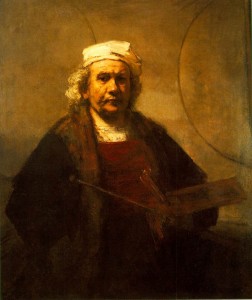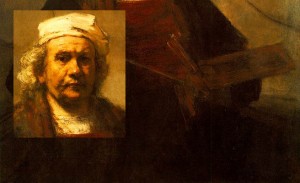Music informs images just as images inform music.
This sounds simple enough, it is a manifestation of an essential (yet often overlooked) aspect of perception, that of “sense-giving” and of “sense-receiving” (Maurice Merleau-Ponty and, of course, Edmund Husserl, did brilliant work on that).
Visual Music is the manifestation of a dialog between music and images, music (can) give(s) sense to images, images (can) give sense to music.
One could paraphrase Norman McLaren and posit that “Visual Music is what happens between the music and the images.”
However, if one reflects on that “simple” truth, where does this “between” exist?
Visual Music and Animation (either “habitual” or “experimental”) are often driven by a reliance on a form of “objectivity” that naively posits “music” and “images” as “things-in-themselves,” and the discourse about Visual Music and Animation often revolves around these two “objective” elements.
Yet, if we agree with Maurice Merleau-Ponty (“Perception is constitutive”), we must acknowledge the/our all-important subjectivity as being that which provides (or not) the sense we are talking about, be it given, and/or received.
We are therefore confronted by (the experience of) elements that are always in flux: if one is foreground, the other is background, and if our gaze changes, intentionally or not, the priorities change accordingly.
One extreme of that experience is a “space” between images and music that is flattened, images and music mirror each other (“mickey-mousing”).
The other extreme is a “space” that is so “stretched,” there seems to be little or no connection between the images and the music.
It seems to me that Visual Music is the art of oscillating/navigating between those two extremes, our experience giving birth to the type(s) of “space(s)” our work (can) make manifest.
The “space” that can exist between images and music is itself subject to various tensions: it can be “literal” (based on a strong and steady figure/ground differentiation, images and music are clearly two different “things”), or it can be “equivocal” (in which figure and ground are no longer differentiated in a “reliable” way, reversals loom large, and the music and images take turn in coming to the fore, with moments of grace during which they no longer can be identified as separate elements).
This latter “space,” sometimes called “equivocal” or “a-dimensional,” is the one that fascinates me, and it happens to be a space that has long been at the heart of the language of music (melody and accompaniment may alternate in the foreground and background, etc.).
Music is a privileged Art form which provides moments of grace during which one no longer can differentiate between the different elements.
Great painters, regardless of the time at which they lived, have clearly demonstrated their awareness and mastery of the potentially reversible status of the visual elements they create/work with, “sense-giving” and “sense-receiving” are the foundation on/from which they create/receive their Art.
See this Rembrandt self-portrait and compare the definition of the face with that of the hand holding the palette:
But, as long as one relies on the (often linear) structure (visual and temporal) provided by both the story/music and the images, one is likely to miss all the possibilities offered by this constantly evolving transformation, figure becoming ground and ground becoming figure, this giving sense, that receiving it, soon followed by that providing sense and this receiving it, all in a creative dance that can take one to unforeseen places….
“There’s another way to live. accept indeterminacy as a principle, and you see your life in a new light, as a series of seemingly unrelated jewel-like stories …within a dazzling setting of change and transformation. recognize that you don’t know where you stand, and you will begin to watch where you put your feet. that’s when the path appears.” – John Cage.
Lots to reflect upon in what Cage tells us, but let me emphasize this: unlike the common assumption stating that animation is about “movement,” I am convinced that it is above all about change and transformation. If one is not dealing with figure/ground differentiation, no-thing moves, at least not in a reliable (differentiated) way, but every “thing” is possibly under constant change and transformation…
See these examples:
and here
Connecting with and making visible this type of space is not accomplished “magically” by merely working with “abstract images:” doodles on a ground, mere “abstract cartoons,” never reach the threshold of equivocal (undifferentiated) space.
Many painters (figurative and abstract) have shown us that equivocal space is (at) the heart of their art, one only needs spend time in front of their work to realize how far it is from the world of “illustration” (to quote one of those painters, Philip Guston: “If I can tell at a glance what any of Rembrandt’s students’ work is about, I do not have a clue what it is that Rembrandt was doing”).
Their work makes manifest the reality of “sense-giving/sense-receiving.”
In Visual Music, that challenge is daunting! Music is often multi-faceted, with events/gestures happening -in time- on many levels, simultaneously yes, and often, on/in different time(s) as well.
What does (one make) the images talk/dance to/with?
The melody, the bass, the beat, the accompaniment, what?
Along the possible figure/ground reversals available in visual art, music adds the dimension of time, a dimension in which the same reversals can happen, but on a different axis, an axis on which cinema/time-art thrive.
There are so many possibilities, whatever one chooses is exactly that, a choice, and a choice that is likely to be very different if exercised by different people, or by the “same” person at different times in his/her life.
The pull of all these possible choices create fragmentation, a fragmentation which, as the history of painting and music clearly shows, has entered the world of Art many decades ago (as is so often the case, Art makes the world of human experience visible while shaping it as well, another facet of “things informing each other”).
To quote Robert Filliou: “Art s what makes Life more interesting than Art.”
To become aware of that inherent fragmentation requires one “hears with one’s eyes” in a non-linear way, something akin to “global listening,” holding many things at once, often experienced as if one were getting lost in the middle of many solicitations, though doing so consciously, with as much attention and goodwill as one can summon.
As the saying goes: “talent is not demonstrated by how much one knows, but by how well one can function when no longer knowing what to do.”
When that is experienced and surrendered to, it often yields images/sequences that are unpredictable, showing how much wisdom there is, for the sincere practitioner, in Pablo Picasso’s saying: “What saved me is that I became more interested in what I found than in what I was looking for.”
I posit that, in order to explore this elusive space between music and images, we need to (re)connect with the experiential (“coming back to our senses”), with “the artist as a vessel,” the one through which “something” makes itself manifest.
My experience as a painter really helped me in this matter, even if, for the longest time, computers resisted my need to proceed by way of accident(s), a simple given when working sincerely with natural media (as Milton Resnick, another painter, once said: “In all my years of fighting with the brush, the brush has always won.”).
For decades, it has been very clear to me (and to many others) that the work made “by accident” has always been more interesting than the work done intentionally.
I trust there is a lot more to “it” than that, that there is a lot more to us than that, and I concur with my old friend the great philosopher José Huertas-Jourda (1993-2007) who used to tell his students: “Trust your darkness.”
Much of the above has been developed in my 6 “Notes from the Underground” available starting here: Notes from the Underground #1 (published by AWN in 2002). (http://www.nondidjuti.net/animation/part_1.html)
And of course, given most of my work is about the exploration of “all that,” there are over 100 clips available here:
http://vimeo.com/jeandetheux
Belgian born, graduate of the Académie Royale des Beaux-Arts (Liège).
In Canada/U.S since 1971.
Has taught “Art” in Canada and the US (NY Studio School of Drawing, Painting and Sculpture, NYU, Concordia U., Alberta College of Art, etc.).
Artwork (natural media and digital) in private/public collections (in Europe, the Americas, Asia and the Middle-East).
Left natural media (1997, due to sudden deadly allergies to painting materials) for digital technology (started exploring “time-based art”).
Films with the National Film Board of Canada (“Liaisons” and “Rupture”), numerous films in festivals since 2005.
Focuses on the importance of the hand gesture in image making (“le geste révélateur”), and especially, on the exploration of “inherent animation” (that which is done/found “by accident”), avoids “smarts” like the plague, believes that the conceptual approach is a dead-end.
Numerous lectures (in the US, Canada, Australia, Denmark, Lebanon, Belgium), conducts master-classes (including in music schools), has written many articles (AWN, SAGE, VFXWorld, NFB, The Wig, International Journal of Arts and Technology, etc.)makes films and also participates in concerts, creating images in real-time in collaboration with musicians (improvising and/or not).



Just noticed that the links to the two clips used to illustrate the intentional lack of figure/ground differentiation are now missing in the body of the above article, so here they are:
first example: https://vimeo.com/67142233
second example: https://vimeo.com/67131024
The National Film Board of Canada has posted, in its entirety, the film the above illustrations (“Kora Derome” and “Bleu Derome”) were created for.
The film can be viewed here: https://www.nfb.ca/film/liaisons_fr
Here’s a very interesting article that further explores the notion that conceptualism is (at) a dead-end, in any art form, not “just” in poetry: http://tinyurl.com/maan6tc